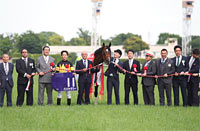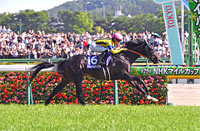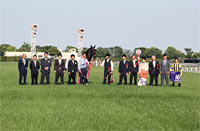NHK Mile Cup (G1) - Data Analysis
G1 race that brings together leading 3-year-olds with various backgrounds
The NHK Mile Cup will celebrate its 25th anniversary this year. While foreign-bred horses dominated the race in its early days, consistently occupying the Top 2 in the first six years, the race has since gained a reputation as a G1 clash between a diverse lineup of 3-year-olds without distinct trends in their birthplace, gender, or prep races leading up to this race. So, which runner will take the crown this year? Let’s take a look by analyzing results from the last 10 years.
Favoritism a stable indicator with trend pointing to runners backed as 2nd favorites
Looking at performances by runners over the last 10 years in terms of favoritism, we find that race favorites have produced five winners and achieved a Win ratio of 50.0%, while runners backed as 2nd favorite have produced two winners and achieved a Top 2 ratio of 50.0%. In other words, highly favored runners have consistently finished well. Incidentally, 2013 was the only year in which the Top 2 favorites were both beaten to 4th or lower. Consequently, focusing on the runners backed as 1st and 2nd favorite may be an effective approach to increase our strike rate. In the last five years, runners backed as 2nd favorite have delivered notably strong performance, with Admire Mars finishing 1st in 2019, Gibeon 2nd in 2018, Aerolithe 1st in 2017, Lord Quest 2nd in 2016, and Musee Sultan 3rd in 2015. [Table 1]
[Table 1] Performance by favoritism (last 10 years)
| Favoritism |
Performance
[1st-2nd-3rd-4th or lower] |
Win ratio |
Top 2 ratio |
Top 3 ratio |
| 1st favorite |
5-0-0-5 |
50.0% |
50.0% |
50.0% |
| 2nd favorite |
2-3-1-4 |
20.0% |
50.0% |
60.0% |
| 3rd favorite |
1-1-1-7 |
10.0% |
20.0% |
30.0% |
| 4th favorite |
0-1-1-8 |
0% |
10.0% |
20.0% |
| 5th favorite |
0-1-0-9 |
0% |
10.0% |
10.0% |
| 6th-10th favorite |
2-1-4-43 |
4.0% |
6.0% |
14.0% |
| 11th favorite or lower |
0-3-3-74 |
0% |
3.8% |
7.5% |
Strong performance by runners coming from a graded race
Looking at performances by runners over the last 10 years in terms of the grade of their previous race, we observe a difference in success ratios between runners coming from a graded race on the one hand, and those coming from an allowance-class or open-class race on the other, with the first group delivering higher success ratios. In recent years, many winners had not only contested a G1 race in their last outing, but had also finished in the Top 5 of that race, including 2019 winner Admire Mars (previously finished 4th in Satsuki Sho), 2017 winner Aerolithe (5th in Oka Sho (Japanese 1000 Guineas)), 2016 winner Major Emblem (4th in Oka Sho), and 2015 winner Clarity Sky (5th in Satsuki Sho (Japanese 2000 Guineas)). Conversely, the 33 runners over the last 10 years that had contested an allowance-class or open-class race in their last outing produced zero winners. [Table 2]
[Table 2] Performance by grade of previous race (last 10 years)
Grade of
previous race |
Performance
[1st-2nd-3rd-4th or lower] |
Win ratio |
Top 2 ratio |
Top 3 ratio |
| G1 |
4-1-2-28 |
11.4% |
14.3% |
20.0% |
| G2 |
4-2-5-56 |
6.0% |
9.0% |
16.4% |
| G3 |
2-5-3-35 |
4.4% |
15.6% |
22.2% |
| Open class |
0-2-0-27 |
0% |
6.9% |
6.9% |
| Allowance class |
0-0-0-4 |
0% |
0% |
0% |
Watch for runners coming from longer-distance races last time out
Looking at performances by runners over the last 10 years in terms of the distance of their previous race, we note that the runners that produced the highest number of winners (seven over 10 years) had also contested a 1,600m race in their last outing. These included runners coming from the New Zealand Trophy (an NHK Mile Cup prep race) and from the Oka Sho. However, if we observe the Top 3 ratio, runners coming from a race longer than a mile have produced better than those over a mile. For example, Cadence Call, who was backed as 14th favorite and finished as the runner-up in the 2019 race, had contested the Mainichi Hai last time out and finished 4th in that race. Compared with runners coming from a race with the same or a longer distance than the NHK Mile Cup, we find that runners coming from a race with a shorter distance (previous race of below 1,600m) had significantly lower success ratios, which warrants attention. [Table 3]
[Table 3] Performance by distance of previous race (last 10 years)
| Distance of previous race |
Performance
[1st-2nd-3rd-4th or lower] |
Win ratio |
Top 2 ratio |
Top 3 ratio |
| Shorter than 1,600m |
0-2-0-39 |
0% |
4.9% |
4.9% |
| 1,600m |
7-2-5-80 |
7.4% |
9.6% |
14.9% |
| Longer than 1,600m |
3-6-5-31 |
6.7% |
20.0% |
31.1% |
Runners with zero wins since start of the year perform surprisingly well
Runners that had achieved three or more wins since the turn of the year delivered a decent Top 2 ratio of 40.0%. However, runners that had achieved only two such wins had a lackluster Top 3 ratio of 8.3%, and race favorites Grand Silk in 2015 and A Shin Top in 2013 both fell short of expectations. An interesting approach would be to single out runners that have not won a race since the turn of the year. Runners that have notched zero wins since they turned three may set their sights on the NHK Mile Cup in the spring season. Such runners occupied the entire Top 3 in 2019 (Admire Mars, Cadence Call, Catedral), and the same pattern was seen in 2017. [Table 4]
[Table 4] Performance by number of wins since the turn of the year (last 10 years)
| Number of wins |
Performance
[1st-2nd-3rd-4th or lower] |
Win ratio |
Top 2 ratio |
Top 3 ratio |
| 3 wins |
1-1-0-3 |
20.0% |
40.0% |
40.0% |
| 2 wins |
1-1-0-22 |
4.2% |
8.3% |
8.3% |
| 1 win |
4-2-2-59 |
6.0% |
9.0% |
11.9% |
| 0 wins |
4-6-8-64 |
4.9% |
12.2% |
22.0% |
Seek out the winner!
Trend in pedigree of winners
Runners by Daiwa Major have performed well in the NHK Mile Cup, with Curren Black Hill (first-year crop) winning in 2012, Major Emblem in 2016, and Admire Mars in 2019. Daiwa Major has produced the largest number of NHK Mile Cup winners, as well as less-favored runners who went on to perform well, including Flamme de Gloire (finished in 3rd place in 2013, backed as 8th favorite) and Bom Servico (finished in 3rd place in 2017, backed as 6th favorite), providing further evidence that Daiwa Major is the top sire to watch in this race. Other important sires to keep an eye on are Deep Impact and Kurofune. The last six victories have rotated between runners produced by these three sires. If placing emphasis on bloodlines, our focus should be on these three sires. [Table 5]
[Table 5] Sires of winners (since 2012)
| Year |
Winner |
Sire |
| 2012 |
Curren Black Hill |
Daiwa Major |
| 2013 |
Meiner Ho O |
Suzuka Phoenix |
| 2014 |
Mikki Isle |
Deep Impact |
| 2015 |
Clarity Sky |
Kurofune |
| 2016 |
Major Emblem |
Daiwa Major |
| 2017 |
Aerolithe |
Kurofune |
| 2018 |
Keiai Nautique |
Deep Impact |
| 2019 |
Admire Mars |
Daiwa Major |
(Yodohito Himezono)
|

- Preview
- Barrier draw
- Past performances of runners

- News
- Race result
- Video
- 2025 English

- 2024 English

- 2023 English

- 2022 English

- 2021 English

- 2020 English

- 2019 English

- 2018 English

- 2017 English

- 2016 English

- 2015 English

- 2014 English

- 2013 English

- Photo Gallery
2025 Winner: Panja Tower


2024 Winner: Jantar Mantar


|



















